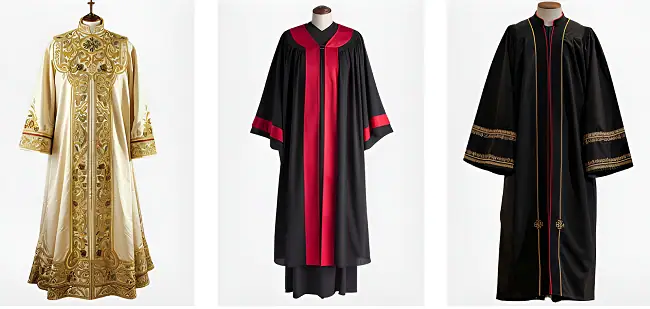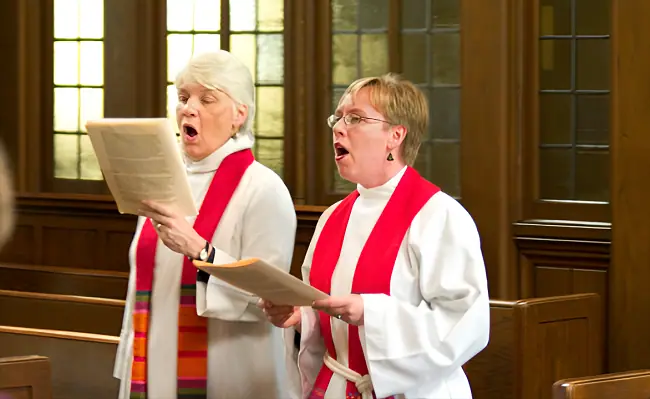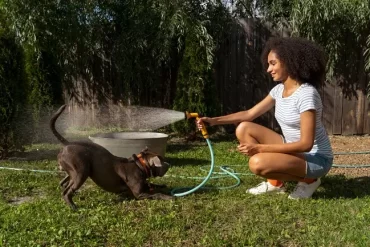Clergy Robes for Women started way back in 1215 because of a decision by the Fourth Lateran Council. They said all Christian clergy needed to wear special clothes. But it wasn’t to make them seem special or important. The idea was to make them easy to spot in a crowd.
Think about seeing a clergy member and knowing right away who they are just by what they’re wearing. Even though the clergy robes for women have changed a bit over the years, this early choice is why clergy today wear such unique outfits.

Now, let’s find out more about when women started wearing clergy robes and how they’ve looked over the years.
What are clergy robes called?
clergy robes are special clothes that priests, ministers, and other religious leaders wear. These clothes are different from the fancy outfits they wear during church services, which are called vestments. The robes clergy wear every day aren’t just for church. Sometimes, they even wear them under their vestments.
One popular piece of clergy clothing you might have seen is a shirt with a special collar called a clerical collar. It’s a simple shirt, but that collar makes it stand out. This style is common among many Christian groups.
Now, you might wonder who wears these robes the most. Well, Catholic priests are often seen in robes, as are Anglican, Oriental Orthodox, and Eastern Orthodox clergy. These robes help people recognize them, even when they’re out on the street.
It’s interesting to note that some female clergy clothing looks similar to what monks or nuns wear. You know, those long robes or habits you might have seen in pictures or movies. It’s like a special uniform that tells us about the person’s role in the church.
The Invention of the Robe:
Robes have a history that goes back to the 19th century. Back then, people wore something called banyans. These were special gowns from India or Persia. They were like today’s robes, but fancier and only for the rich people. These banyans were for wearing at home when relaxing.
The early robes were loose and looked like kimonos from Japan. They didn’t have a front that closed; it was open all the way. Over time, people started to change the design. They added things like collars, buttons, pockets, and a tie around the waist. This made the robe look more like a coat you might wear outside.

Even though the style changed, some things stayed the same. People still liked to use bright colors for their robes. They also used fabrics that had fancy designs or decorations on them.
Robes have always been about comfort and style. They started as something only a few people could wear. But as time went on, more and more people started wearing clerics clothes and clergy attire. They became popular not just for lounging at home, but also for special events or ceremonies.
What is a female priest called?
You might wonder what we call a female priest. The answer is a “priestess.” The word “priestess” comes from the word “priest,” but it’s for women. The word “priest” comes from Old English and a Greek word, “presbyteros,” which means “an elder.”
Long ago, a priestess was just like a priest, but for women. They did the same kind of work in the church and helped people with their faith. But things have changed over time. Nowadays, when people talk about someone leading a Christian church service, they usually use the word “priest,” whether it’s a man or a woman.
Were there women priests in the early church?
Some historians, like Gary Macy, Kevin Madigan, and Carolyn Osiek, say they have found proof of women who were ordained as priests. They’ve looked at old documents and found stories about these women.
In 2021, a really exciting discovery happened. People found an old church that’s 1,600 years old. Inside this church, there were beautiful mosaics on the walls. These mosaics showed women doing special jobs in the church. They weren’t the main priests, but they had important roles as deacons. A deacon helps the priest and takes care of the church and the people in it. Some people also think that these women might have led convents, which are places where nuns live and pray.
There’s also a letter from a man named Paul in the Bible. He wrote to a group of people in Rome a long time ago, around the first century AD. In this letter, Paul mentions a woman deacon. This shows that even back then, women were part of the church leadership.
The First Lady in Church
For a long time, the wife of the pastor in American churches had a special place on Sundays. She was often called the “first lady” and sat on the third pew to the left. This was a place of honor and respect. People looked up to her and she was seen as a pillar of support for her husband, the pastor. She would help him with church work and sometimes even teach Sunday School.
In many churches, there were special places for different groups of people. There were rows for older people, seats for Sunday School teachers, and benches for kids who liked to giggle and whisper. But none of these seats were as important as the third pew on the left where the pastor’s wife sat.
Over time, things have started to change. Today, many first ladies are doing much more than just sitting on a pew. They are taking on bigger roles, helping their communities, and making a difference in the world. They are like Michelle Obama, who was a strong and active First Lady of the United States.
Take Lynne Hybels, for example. She is the first lady of a big church in Illinois. Lynne doesn’t just sit on the third pew; she travels around the world to help people in need. She visits places like war zones and talks to people from different religions to promote peace.
Then there’s Tara Jenkins, who leads a group for pastors’ wives. She helps them find their own paths and use their talents to help others. Tara believes that pastors’ wives have a lot of potential to do good in their communities.
Kay Warren is another example. She and her husband started a program to help people with HIV/AIDS. They also help find homes for children who don’t have parents. Kay is very busy, but she believes it’s important to help others, no matter how busy you are.
The debate about women becoming priests:
In many Christian traditions like the Catholic and Orthodox churches, women aren’t allowed to become priests. The main reason given is that priests should represent Jesus, who is seen as male. Some church leaders, including the Pope, say this is why women can’t be priests. They often compare women to the Virgin Mary, who is important but not seen as a direct representation of God like Jesus.
The Pope wrote a letter in 1995 where he thanked women for their roles but didn’t support them becoming priests. He believes that men and women have different roles and that’s okay. But many people, especially women, disagree. They feel left out because they can’t be priests and do important priestly jobs like counseling people or saying Mass.
Some church leaders say women have done great things in the church, like starting religious orders and leading important ministries. They mention women like St. Frances Xavier Cabrini and St. Elizabeth Ann Seton, who made big contributions to the church. These leaders believe that even if women can’t be priests, they still have an important place in the church.
However, many people think women should be allowed to be priests. They believe that if women have done so much for the church, they should be able to have the same power and responsibilities as men. Some think that the church is holding onto old ideas that don’t fit today’s world. They say that if the church wants to treat men and women equally, it should let women become priests too.
The debate about women becoming priests continues. While some church leaders say it’s against the rules, others think it’s time for a change. As more people talk about this issue, it’s possible that the church might change its mind in the future.
Wrapping Up
From the early days of the church to today, the roles and outfits of religious leaders have changed a lot. Women have played vital roles, whether as deacons, church leaders, or supportive first ladies. While some traditions have kept women from being priests, many people are discussing if it’s time for a change. The church is a place full of history, stories, and important decisions that affect people’s lives.
Do you have any stories or thoughts about this topic? We’d love to hear from you and share your experiences or thoughts with us!







